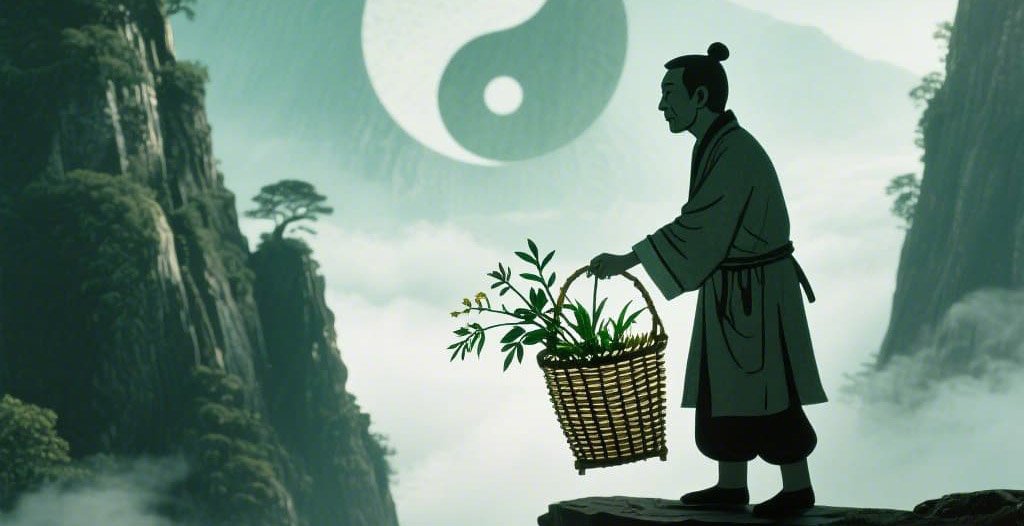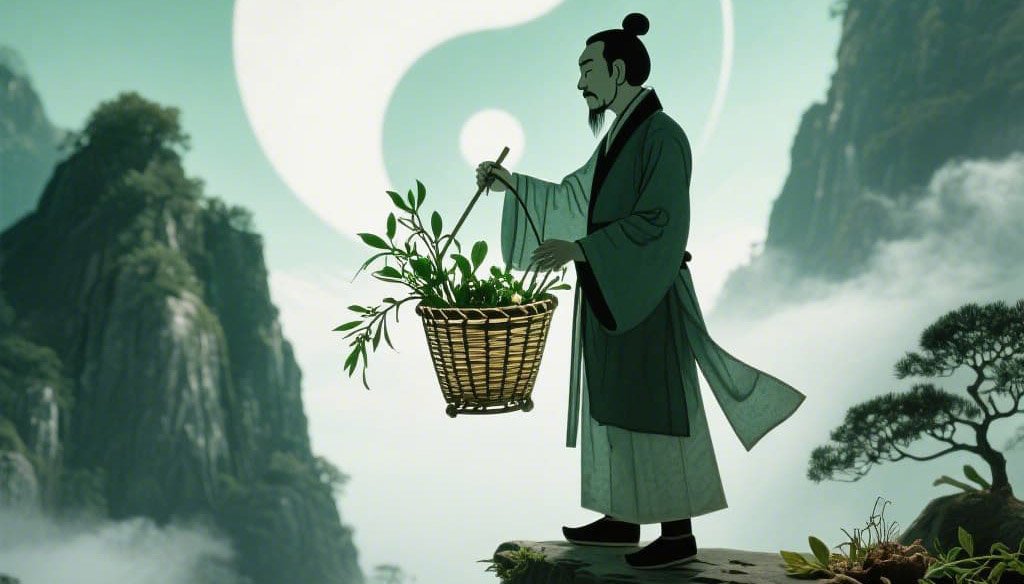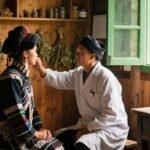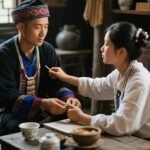Gaojiachong (Rheumatoid Arthritis)
Overview
In Miao medicine, rheumatoid arthritis is called Gaojiachong (also known as Jiangfengjin or Enianggangbang). It occurs in individuals with weak constitutions—particularly the elderly or those overworked—or who live in cold, damp environments, allowing wind–damp–heat pathogens to invade the joints.
In Traditional Chinese Medicine, rheumatoid arthritis falls under bi syndrome, where invasion by wind, cold, damp, or heat blocks the channels, leading to impaired qi–blood circulation. Clinically, this presents as aching, numbness, heaviness, and restricted flexion–extension of muscles, bones, and joints, sometimes with joint swelling and burning sensations. The disease often progresses or recurs over time.
In Western medicine, joint deformity, stiffness, and muscle wasting caused by rheumatoid arthritis can be managed using similar syndrome-based differentiation.
Miao Classification
Gaojiachong is a major disorder with two subtypes:
Cold–Meridian Rheumatoid Arthritis
Heat–Meridian Rheumatoid Arthritis
Causes
Miao medicine teaches that innate constitution varies. Those with weaker constitutions resist dampness poorly. Chronic overwork, poor housing, and inadequate heating in winter expose people to damp–cold, predisposing them to “wind–damp” invasion.
Pathogenesis
Wind–cold–damp–heat toxins invade limb channels and joints, obstructing qi flow and weakening blood nourishment. This leads to pain, numbness, and swelling; over time, qi–blood become further depleted, resulting in chronic joint inflammation and deformity.
Diagnosis
Diagnostic Basis
Occurs at any age or gender, especially in manual laborers and athletes.
Onset may be sudden or gradual, with muscle/joint pain and limited flexion–extension. Pain may migrate, worsen in cold, and ease with heat. Joints can feel heavy and numb; some see warmth and redness, or deformity and persistent aching, often accompanied by palpitations and fatigue.
Tongue: red body, white slippery coating. Pulse: deep–tight, deep–wiry, or deep–slow–choppy.
Supporting Tests
CBC, urinalysis, stool exam, blood biochemistry, ECG, X-ray for initial screening.
CT, MRI, joint arthrography, or arthroscopy to confirm joint involvement.

Differential Diagnosis
Gayianmai (Wei Syndrome) presents with limb flaccidity, muscle weakness, and atrophy—lacking the pain, heat, and swelling that characterize Gaojiachong.
Pattern Differentiation & Treatment
1. Cold–Meridian Rheumatoid Arthritis
Manifestations: Fever, aversion to wind, numbness and cold pain in affected joints, stiffness, and weakness.
Principle: Expel wind–damp and cold, unblock channels, relieve pain.
Formula (Decoction):
Sheng Chelong (Raw Chelong, sheng che long) 20g
Ba jiao feng (Schefflera octophylla, ba jiao feng) 10g
Wei ling xian (Clematis root, wei ling xian) 20g
Shui dong gua (Benincasa seed, shui dong gua) 15g
Herb Actions:
Sheng Chelong warms and dispels wind–damp, unblocks channels.
Ba jiao feng warms, disperses cold, relieves pain, and resolves dampness.
Wei ling xian warms, moves qi, and relieves pain.
Shui dong gua activates blood, disperses stasis, and relaxes sinews.
2. Heat–Meridian Rheumatoid Arthritis
Manifestations: Red, swollen, hot, painful joints; fever; thirst; aversion to wind.
Principle: Clear heat and drain dampness, relax sinews, unblock channels, relieve pain.
Formula (Decoction):
Xi an xian cao (Agrimonia pilosa, xi xian cao) 20g
Ren dong teng (Lonicera stem, ren dong teng) 15g
Xu chang qing (Radix changqing, xu chang qing) 20g
Mu gua (Papaya seed, mu gua) 20g
Herb Actions:
Xi an xian cao clears heat, dispels damp, and relieves pain.
Ren dong teng clears heat, detoxifies, and cools blood.
Xu chang qing opens channels, detoxifies, and reduces swelling.
Mu gua soothes sinews, calms the liver, and dispels damp.
Prevention & Care
Protect against cold and damp—keep joints warm and dry.
Avoid sweating then exposure to wind or water immediately after activity.
Balance work and rest; maintain regular meals, moderate exercise (e.g., Tai Chi, self-massage).
Strengthen constitution with proper nutrition, sleep, and stress management.
Limit cold, damp foods (e.g., bamboo shoots, water spinach).

Notes
Miao medicine holds that Gaojiachong arises when wind–cold–damp pathogens lodge in the sinews and channels. Poor housing and chronic exposure to damp environments—combined with inadequate heating in winter—are primary causes. Prolonged overwork or congenital weakness further depletes the body’s defenses against cold–damp invasion. Therefore, preventing damp-related rheumatism centers on keeping warm and dry, and on strengthening the body through regular exercise to boost resistance.
Mengchong Jing (Bi Syndrome – Rheumatism)
Overview
In Miao medicine, chronic bi syndrome from wind–damp invasion is called Mengchong Jing (also Gaojiabing). It arises from congenital weakness, prolonged residence in damp lowlands, cold climate, or overexertion.
Miao Patterns
Mengchong Jing divides into three minor patterns:
Heat–Damp Conflagration Rheumatism
Heat–Meridian Qi–Stasis Blood–Stasis Rheumatism
Cold–Meridian Cold–Damp Obstruction Rheumatism
Pathogenesis
Miao theory holds that wind–cold–damp–heat toxins invade the limb channels and joints or that overstrain injures qi–blood. Over time, qi stagnates, blood stases, and the sinews lose nourishment, producing pain, numbness, swelling, joint deformity, and restricted motion.
1. Heat–Damp Conflagration Rheumatism
Clinical Manifestations
Onset may be acute or chronic.
Initial redness, swelling, and pain of toe, finger, and palm joints.
Aversion to cold, chills, fever, chest fullness, abdominal distension.
Profuse sweating without relief of heat, joint deformity.
Meridian: Heat meridian, heat disease.
Treatment Principle: Clear heat and drain dampness (qing re li shi); dispel wind and relieve pain (qu feng zhi tong).
Formula (decoction):
Weilingxian (Clematis root, wei ling xian) 15g
Sanjiaofeng (Three-lobe burning bush, san jiao feng) 10g
Yizhihua (One-branch flower, yi zhi hua) 15g
Herb Actions
Weilingxian: Cold, bitter—enters heat meridian; dispels wind–damp, unblocks channels, relieves pain.
Sanjiaofeng: Cold, bitter—enters heat meridian; clears heat, detoxifies, reduces swelling, relieves pain.
Yizhihua: Cold, bitter, slightly toxic—enters heat meridian; disperses wind, clears heat, detoxifies, reduces swelling.
2. Heat–Meridian Qi–Stasis Blood–Stasis Rheumatism
Clinical Manifestations
Recurrent joint pain, difficult to (supports).
Heaviness of limbs, joint redness and swelling, limited flexion/extension.
Low-grade fever after activity, night sweats.
Meridian: Heat meridian, heat disease.
Treatment Principle: Expel damp (qu shi); smooth the channels (shu jing tong luo); move qi and relieve pain (xing qi zhi tong).
Formula (decoction):
Biejia (Turtle shell, bie jia) 12g
Yiyiren (Coix seed, yi yi ren) 15g
Qinghao (Artemisia, qing hao) 12g
Sangzhi (Mulberry twig, sang zhi) 15g
Sheng Chelong (Raw Tsuga, sheng che long) 20g

Herb Actions
Biejia: Cold, salty—enters heat meridian; nourishes yin, tonifies kidney, invigorates blood.
Yiyiren: Neutral, sweet—enters spleen and kidney meridians; strengthens spleen, drains damp, clears heat, detoxifies.
Qinghao: Cold, bitter—enters heat meridian; clears summer heat, cools blood, detoxifies.
Sangzhi: Cold, bitter—enters heat meridian; disperses wind–damp, unblocks channels.
Sheng Chelong: Cold, sweet—enters heat meridian; dispels wind–damp, unblocks channels, relieves pain.
3. Cold–Meridian Cold–Damp Obstruction Rheumatism
Clinical Manifestations
Joint swelling, deformity, restricted movement, loss of function.
Muscle wasting, pale complexion, shortness of breath, aversion to cold.
Night fever, sweating on exertion.
Meridian: Cold meridian, cold disease.
Treatment Principle: Combine attacking pathogens and tonification (gong bu jian shi).
Formula (decoction):
Tiejiaozi (Iron stick herb, tie jiao zi) 15g
Chuanxiong (Ligusticum, chuan xiong) 15g
Zhi Cao Wu (Processed Aconite, zhi cao wu) 8g
Xuduan (Dipsacus root, xu duan) 20g
Herb Actions
Tiejiaozi: Warm, numbing-spicy—enters cold meridian; clears heat, moistens dryness, moves qi.
Chuanxiong: Warm, pungent—enters cold meridian; moves qi, relieves pain.
Zhi Cao Wu: Hot, toxic—enters cold meridian; dispels wind–damp, relieves pain, warms interior.
Xuduan: Warm, sweet—enters cold meridian; tonifies liver–kidney, strengthens sinews and bones.
Disclaimer:
This article is provided solely for the cultural and educational study of traditional medicine. It is not medical advice. Consult a licensed physician before applying any treatments.



Leave a Reply